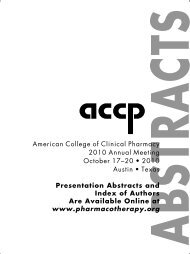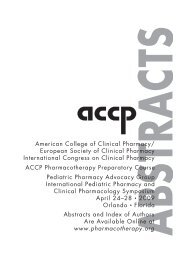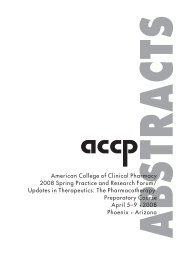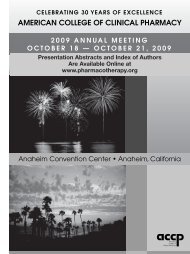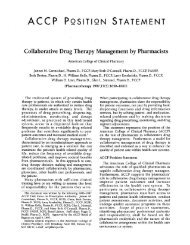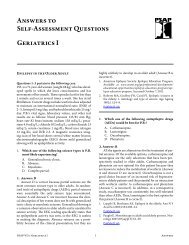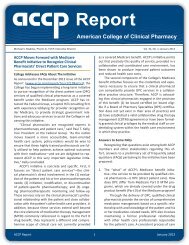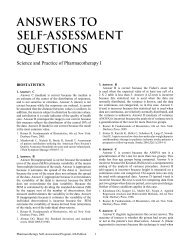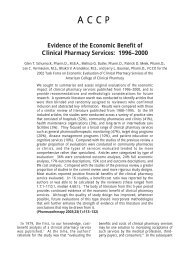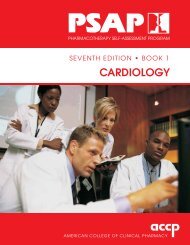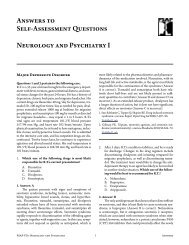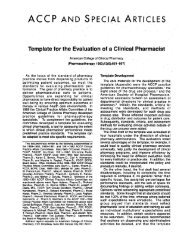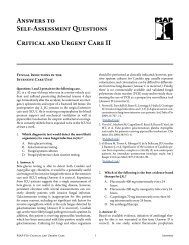Answers to Self-Assessment Questions - ACCP
Answers to Self-Assessment Questions - ACCP
Answers to Self-Assessment Questions - ACCP
Create successful ePaper yourself
Turn your PDF publications into a flip-book with our unique Google optimized e-Paper software.
1. Consensus recommendations from the U.S. Summit on<br />
immune-enhancing enteral therapy. JPEN J Parenter Enteral<br />
Nutr 2001;25:S61–S63.<br />
2. Kudsk KA. Immunonutrition in surgery and critical care.<br />
Annu Rev Nutr 2006;26:463–79.<br />
42. Answer: B<br />
In patients like J.B. with ARDS and acute lung injury<br />
(ALI), immune-enhancing EN formulations supplemented<br />
with the omega-3 PUFAs (eicosapentaenoic acid [EPA]<br />
and g-linolenic acid [GLA]) and antioxidants have been<br />
associated with decreased mortality and improved<br />
oxygenation. The immune-enhancing EN formulation<br />
with omega-3 PUFAs 8.6 g/L and antioxidants (Answer<br />
B) contains these nutrients and is therefore the best choice.<br />
The standard EN formulation with enteral glutamine<br />
supplementation (Answer C) is not the best option because<br />
it does not contain omega-3 PUFAs or antioxidants. Neither<br />
Answer A (immune-enhancing EN formulation with<br />
arginine, nucleotides, and omega-3 PUFAs) nor Answer<br />
D (immune-enhancing EN formulation with arginine and<br />
omega-3 PUFAs) is best for J.B. at this time because each<br />
contains arginine, which has been associated with potential<br />
harm in patients with sepsis.<br />
1. Pontes-Arruda A, Aragao AM, Albuquerque JD. Effects of<br />
enteral feeding with eicosapentaenoic acid, gamma-linolenic<br />
acid, and antioxidants in mechanically ventilated patients with<br />
severe sepsis and septic shock. Crit Care Med 2006;34:2325–<br />
33.<br />
2. Kreymann KG, Berger MM, Deutz NE, Hiesmayr M, Jolliet<br />
P, Kazandjiev G, et al. ESPEN guidelines on enteral nutrition:<br />
intensive care. Clin Nutr 2006;25:210–23.<br />
43. Answer: C<br />
Once J.B. is started on an immune-enhancing EN<br />
formulation, the duration of therapy will have <strong>to</strong> be decided.<br />
Clinical studies indicate that the greatest benefit from these<br />
formulations in patients with ARDS is obtained when therapy<br />
is continued until the patient has been extubated (Answer<br />
C); thus, Answer C is the best answer. Patients are unlikely<br />
<strong>to</strong> benefit from any immunonutrition therapy administered<br />
for only 2 days (Answer A) or 4 days (Answer B), and there<br />
is no clinical evidence that patients with ARDS derive any<br />
further improvement in outcome if immune-enhancing<br />
diets are used after they have recovered sufficiently <strong>to</strong> be<br />
extubated. Because hospital discharge will generally occur<br />
days <strong>to</strong> weeks after extubation, discontinuing the product on<br />
discharge (Answer D) is not appropriate for the duration of<br />
J.B.’s immunonutrition therapy.<br />
1. Pontes-Arruda A, Aragao AM, Albuquerque JD. Effects of<br />
enteral feeding with eicosapentaenoic acid, gamma-linolenic<br />
acid, and antioxidants in mechanically ventilated patients with<br />
severe sepsis and septic shock. Crit Care Med 2006;34:2325–<br />
33.<br />
2. Consensus recommendations from the U.S. Summit on<br />
immune-enhancing enteral therapy. JPEN J Parenter Enteral<br />
Nutr 2001;25:S61–S63.<br />
44. Answer: C<br />
If a patient with ARDS receiving an immune-enhancing<br />
EN formulation was evaluated for immunologic and<br />
inflamma<strong>to</strong>ry markers, the result likely would reflect the<br />
increased use of omega-3 PUFAs, which is associated<br />
with a decrease in inflamma<strong>to</strong>ry media<strong>to</strong>rs and markers.<br />
Thus, the concentrations of prostaglandin E 2<br />
(Answer D)<br />
and interleukin 6 (IL-6) (Answer B) would be expected<br />
<strong>to</strong> decrease, not increase, making Answer B and Answer<br />
D incorrect. Tumor necrosis fac<strong>to</strong>r alpha concentrations<br />
(Answer C) decrease with the addition of PUFAs <strong>to</strong> the<br />
diet; thus, Answer C is correct. Although these immuneenhancing<br />
EN formulations may alter T lymphocyte<br />
function, <strong>to</strong>tal lymphocyte count would not be expected <strong>to</strong><br />
decrease (Answer A); thus Answer A is incorrect.<br />
1. Suchner U, Kuhn KS, Furst P. The scientific basis of<br />
immunonutrition. Proc Nutr Soc 2000;59:553–63.<br />
2. Pacht ER, DeMichele SJ, Nelson JL, Hart J, Wennberg AK,<br />
Gadek JE. Enteral nutrition with eicosapentaenoic acid, gammalinolenic<br />
acid, and antioxidants reduces alveolar inflamma<strong>to</strong>ry<br />
media<strong>to</strong>rs and protein influx in patients with acute respira<strong>to</strong>ry<br />
distress syndrome. Crit Care Med 2003;31:491–500.<br />
45. Answer: D<br />
The use of immune-enhancing EN formulations<br />
containing arginine, omega-3 PUFAs, and nucleotides has<br />
been shown <strong>to</strong> improve outcomes in patients after trauma.<br />
The potential benefit is greatest in patients with an injury<br />
severity score (ISS) greater than 20 or an abdominal<br />
trauma index (ATI) greater than 25. The 47-year-old<br />
woman injured in a fall with an ISS of 22 (Answer D) is<br />
the patient most likely <strong>to</strong> derive additional benefit from<br />
the use of immunonutrition. The 32-year-old man with an<br />
ISS of 12 (Answer A), the 29-year-old woman injured in an<br />
industrial accident with a ATI of 22 (Answer C), and the<br />
55-year-old woman injured in an au<strong>to</strong>mobile accident with<br />
an ATI score of 11 (Answer B) do not have markers of injury<br />
severity in the range where a benefit of immunonutrition<br />
has been shown; thus Answer A, Answer B, and Answer C<br />
are incorrect. However, use of these products would not be<br />
expected <strong>to</strong> increase complications.<br />
1. Kudsk KA, Minard G, Croce MA, Brown RO, Lowrey TS,<br />
Pritchard FE, et al. A randomized trial of isonitrogenous<br />
enteral diets after severe trauma. An immune-enhancing diet<br />
reduces septic complications. Ann Surg 1996;224:531–40;<br />
discussion 540–3.<br />
2. Consensus recommendations from the U.S. Summit on<br />
immune-enhancing enteral therapy. JPEN J Parenter Enteral<br />
Nutr 2001;25:S61–S63.<br />
46. Answer: B<br />
Improved outcomes have been demonstrated when<br />
patients with burn injuries like R.R. are given a standard<br />
EN formulation and enteral glutamine supplementation, so<br />
Answer B (begin feeding with a standard EN formulation<br />
with enteral glutamine supplementation) is the correct<br />
answer. Withholding enteral feeding for the first 48 hours<br />
after a thermal injury (Answer D) decreases the likelihood<br />
that EN will be <strong>to</strong>lerated once started; thus, Answer D is<br />
incorrect. Feeding should begin as soon as the patient is<br />
hemodynamically stable after thermal injury. Immuneenhancing<br />
EN formulations supplemented with arginine<br />
12.5, omega-3 PUFAs, and nucleotides (Answer A) or<br />
arginine (Answer C) are not associated with harm in patients<br />
with burns, but they are not recommended for routine use<br />
Pharmacotherapy <strong>Self</strong>-<strong>Assessment</strong> Program, 6th Edition 45 Gastroenterology and Nutrition <strong>Answers</strong>



